

Tony Martignetti is a trusted advisor, leadership coach & facilitator, best-selling author, podcast host, and speaker. He brings together over 25 years of business and leadership experience and extreme curiosity to elevate leaders and equip them with the tools to navigate through change and unlock their true potential. He has been recognized by Thinkers360 as one of the Top 10 Leadership Coaches.
Before becoming the founder and Chief Inspiration Officer of Inspired Purpose Partners, Tony was a finance and strategy executive with experience working with some of the world’s leading life sciences companies. Along his journey, he also managed small businesses and ran a financial consulting company.
Tony hosts The Virtual Campfire podcast and is the author of “Climbing the Right Mountain: Navigating the Journey to An Inspired Life" and the co-author of "Secrets of Next-Level Entrepreneurs." He has been featured in many publications, including Fast Company, Forbes, Life Science Leader, and CEOToday.
Available For: Advising, Authoring, Consulting, Influencing, Speaking
Travels From: Boston
Speaking Topics: Grounded Leadership: Calm In the Chaos, Climbing the Right Mountain, Your Story Has The Power to Inspire, Developing Effective Leadership, Building a
| Tony Martignetti | Points |
|---|---|
| Academic | 0 |
| Author | 1225 |
| Influencer | 284 |
| Speaker | 10 |
| Entrepreneur | 60 |
| Total | 1579 |
Points based upon Thinkers360 patent-pending algorithm.
 How to reclaim your joy, curiosity, and creativity in the workplace
How to reclaim your joy, curiosity, and creativity in the workplace
Tags: Business Strategy, Culture, Leadership
 Focus on the Forest and the Trees: Mastering the Zoom
Focus on the Forest and the Trees: Mastering the Zoom
Tags: Business Strategy, Culture, Leadership
 Inspiring Vision: Palau
Inspiring Vision: Palau
Tags: Business Strategy, Culture, Leadership
 You Are Crafting A Masterpiece: A Call to Outlier Leaders
You Are Crafting A Masterpiece: A Call to Outlier Leaders
Tags: Business Strategy, Culture, Leadership
 Navigating Leadership Vision: The Art of Zooming In and Zooming Out
Navigating Leadership Vision: The Art of Zooming In and Zooming Out
Tags: Business Strategy, Culture, Leadership
 Harnessing Principles for Impactful Leadership: A Guide for Outlier Leaders
Harnessing Principles for Impactful Leadership: A Guide for Outlier Leaders
Tags: Business Strategy, Culture, Leadership
 Unlocking Outlier Thinking: A New Vision for Innovative Leadership
Unlocking Outlier Thinking: A New Vision for Innovative Leadership
Tags: Business Strategy, Culture, Leadership
 Climbing the Right Mountain: Are You on the Right Path?
Climbing the Right Mountain: Are You on the Right Path?
Tags: Business Strategy, Culture, Leadership
 The Power of Artful Connection: Expressing What It Means to Be Alive
The Power of Artful Connection: Expressing What It Means to Be Alive
Tags: Business Strategy, Culture, Leadership
 Nothing Is As It Seems
Nothing Is As It Seems
Tags: Business Strategy, Culture, Leadership
 Embracing the art of curation: Transform your career and enrich your life
Embracing the art of curation: Transform your career and enrich your life
Tags: Business Strategy, Culture, Leadership
 3 Ways Humility Can Undermine Your Leadership
3 Ways Humility Can Undermine Your Leadership
Tags: Business Strategy, Culture, Leadership
 The productivity paradox: How structure creates freedom
The productivity paradox: How structure creates freedom
Tags: Business Strategy, Culture, Leadership
 Thinking ‘Outside the Box’: How Successful Leaders Overcame Their Limiting Beliefs, and How You Can Too
Thinking ‘Outside the Box’: How Successful Leaders Overcame Their Limiting Beliefs, and How You Can Too
Tags: Business Strategy, Culture, Leadership
 The 5 Ps of successful climbing: A leadership compass
The 5 Ps of successful climbing: A leadership compass
Tags: Business Strategy, Culture, Leadership
 Igniting Leadership Potential: Campfire Lessons for the C-Suite
Igniting Leadership Potential: Campfire Lessons for the C-Suite
Tags: Business Strategy, Culture, Leadership
 Are You An Expert Curator? Maybe It Is Time to Get Started
Are You An Expert Curator? Maybe It Is Time to Get Started
Tags: Leadership, Coaching
 The transformative power of proactive leadership: Strategies for your success
The transformative power of proactive leadership: Strategies for your success
Tags: Leadership, Business Strategy, Coaching
 Power of Purpose
Power of Purpose
Tags: Leadership, Culture, Business Strategy
 Embrace Your Uniqueness: The Power of Being You
Embrace Your Uniqueness: The Power of Being You
Tags: Leadership, Coaching
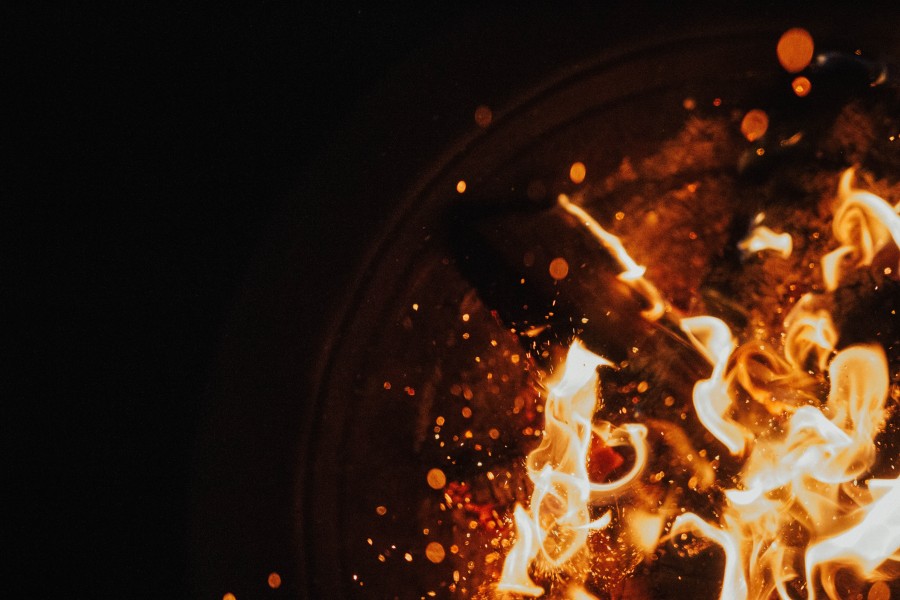 The Beauty of Being Wrong
The Beauty of Being Wrong
Tags: Leadership, Coaching
 The Matrix Paradox
The Matrix Paradox
Tags: Leadership, Culture, Business Strategy
 Don’t Forget the ABCs of a Fulfilling Life
Don’t Forget the ABCs of a Fulfilling Life
Tags: Coaching, Entrepreneurship, Leadership
 One Thing Can Change Everything
One Thing Can Change Everything
Tags: Coaching, Leadership, Management
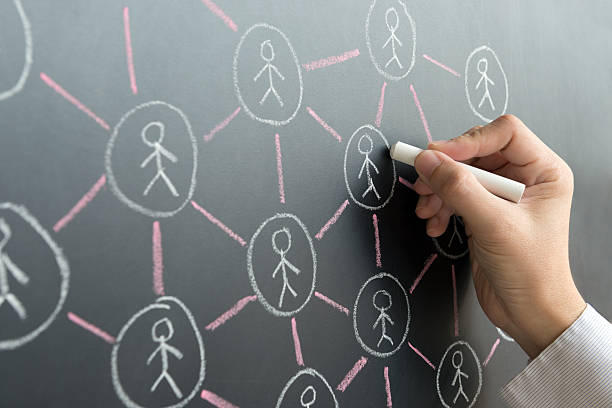 Do You Want To Have More Influence? You Should Increase Your Social Capital
Do You Want To Have More Influence? You Should Increase Your Social Capital
Tags: Management, Leadership, Business Strategy
 What Is Value Creation? Rethinking How Leaders Define, Design, and Deliver Value
What Is Value Creation? Rethinking How Leaders Define, Design, and Deliver Value
Tags: Business Strategy, Culture, Leadership
 What I’ve Learned About People From 10,000+ Hours of Working with Leaders
What I’ve Learned About People From 10,000+ Hours of Working with Leaders
Tags: Business Strategy, Culture, Leadership
 Quieting the Noise: Finding Clarity Amid Chaos
Quieting the Noise: Finding Clarity Amid Chaos
Tags: Business Strategy, Culture, Leadership
 Are You Feeling Unproductive? You Might Need A Focus Filter
Are You Feeling Unproductive? You Might Need A Focus Filter
Tags: Business Strategy, Culture, Leadership
 Houston, We Have a Solution: The Apollo 13 Mission's Virtual Team Triumph
Houston, We Have a Solution: The Apollo 13 Mission's Virtual Team Triumph
Tags: Business Strategy, Culture, Leadership
 Embracing Diversity of Thought: Are You Truly Open-Minded?
Embracing Diversity of Thought: Are You Truly Open-Minded?
Tags: Business Strategy, Culture, Leadership
 Breaking the Monotony: How to Recognize When It's Time for a Pattern Interrupt
Breaking the Monotony: How to Recognize When It's Time for a Pattern Interrupt
Tags: Business Strategy, Culture, Leadership
 Rediscovering Play
Rediscovering Play
Tags: Business Strategy, Culture, Leadership
 Through Expression, We Meet Ourselves
Through Expression, We Meet Ourselves
Tags: Business Strategy, Culture, Leadership
 Don't Check Yourself at the Door
Don't Check Yourself at the Door
Tags: Business Strategy, Culture, Leadership
 How Grateful Leaders Foster Connection and Disrupt the Status Quo
How Grateful Leaders Foster Connection and Disrupt the Status Quo
Tags: Business Strategy, Culture, Leadership
 Taking an Emotional Journey through Time and Space
Taking an Emotional Journey through Time and Space
Tags: Business Strategy, Culture, Leadership
 Find Your Spark
Find Your Spark
Tags: Business Strategy, Culture, Leadership
 When Is “Good Enough” Good Enough?
When Is “Good Enough” Good Enough?
Tags: Business Strategy, Culture, Leadership
 Influence is Power Without Force
Influence is Power Without Force
Tags: Business Strategy, Culture, Leadership
 One Thing Can Change Everything
One Thing Can Change Everything
Tags: Business Strategy, Culture, Leadership
 Orchestrating Serendipity: Cultivating Unexpected Opportunities
Orchestrating Serendipity: Cultivating Unexpected Opportunities
Tags: Business Strategy, Culture, Leadership
 Difficult Conversations Are The Gateway To Understanding
Difficult Conversations Are The Gateway To Understanding
Tags: Business Strategy, Culture, Leadership
 Your Next Big Idea: A Compass for Personal and Professional Growth
Your Next Big Idea: A Compass for Personal and Professional Growth
Tags: Business Strategy, Culture, Leadership
 The Power of Set and Setting: Lessons From Hollywood
The Power of Set and Setting: Lessons From Hollywood
Tags: Business Strategy, Culture, Leadership
 Nature Shows Us the Way; We Just Have to Follow Its Lead
Nature Shows Us the Way; We Just Have to Follow Its Lead
Tags: Business Strategy, Culture, Leadership
 Energy Leadership is a Superpower
Energy Leadership is a Superpower
Tags: Business Strategy, Culture, Leadership
 Glass Blowing and Leadership
Glass Blowing and Leadership
Tags: Business Strategy, Culture, Leadership
 Expectations vs. Reality
Expectations vs. Reality
Tags: Business Strategy, Culture, Leadership
 Imitation to Innovation: Navigating the Originality Trap in Creative Pursuits
Imitation to Innovation: Navigating the Originality Trap in Creative Pursuits
Tags: Business Strategy, Culture, Leadership
 Board Member
Board Member
Tags: Management, Leadership, Coaching
 Campfire Lessons for Leaders
Campfire Lessons for Leaders
Tags: Leadership, Coaching
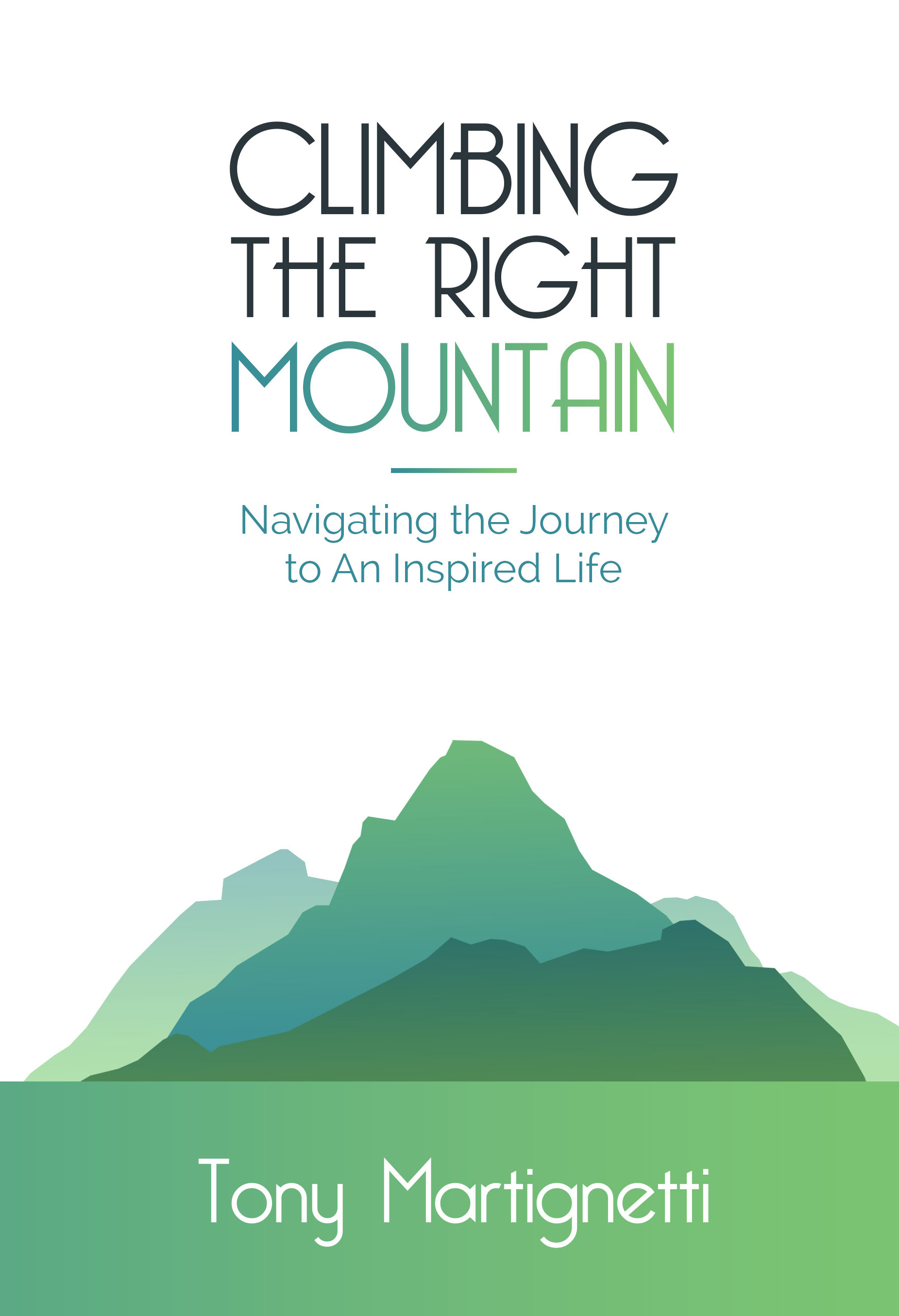 Climbing The Right Mountain: Navigating the Journey to An Inspired Life
Climbing The Right Mountain: Navigating the Journey to An Inspired Life
Tags: Culture, Leadership, Management
 Executive Coach
Executive Coach
Tags: Management, Leadership, Coaching
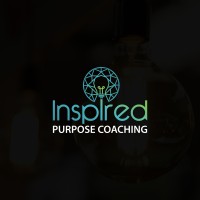 Inspired Purpose Coaching
Inspired Purpose Coaching
Tags: Management, Leadership, Business Strategy
 Brainz CREA Global Honoree 2022
Brainz CREA Global Honoree 2022
Tags: Leadership, Culture, Business Strategy

Tags: Leadership, Business Strategy, Coaching
 Tony Martignetti, Let Your Childhood Artist Live in All You Do
Tony Martignetti, Let Your Childhood Artist Live in All You Do
Tags: Business Strategy, Culture, Leadership
 #777 Developing a Sense of Belonging as a Leader with Tony Martignetti, Founder at Inspired Purpose Partners
#777 Developing a Sense of Belonging as a Leader with Tony Martignetti, Founder at Inspired Purpose Partners
Tags: Business Strategy, Culture, Leadership
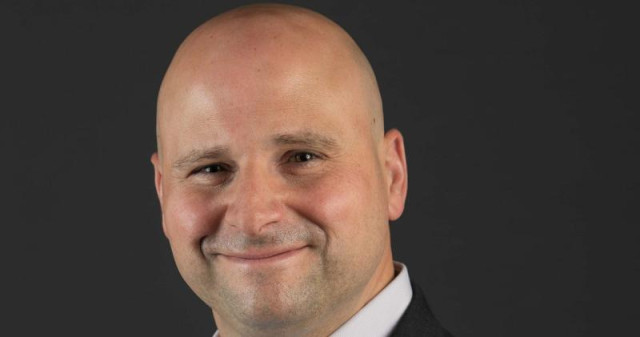 Tony Martignetti of Inspired Purpose Partners On Five Things You Need To Be A Highly Effective Leader During Uncertain & Turbulent Times
Tony Martignetti of Inspired Purpose Partners On Five Things You Need To Be A Highly Effective Leader During Uncertain & Turbulent Times
Tags: Leadership, Coaching
 “Leading and Coaching from Inspired Purpose” with Tony Martignetti | Ep. 092
“Leading and Coaching from Inspired Purpose” with Tony Martignetti | Ep. 092
Tags: Management, Leadership, Coaching
 How To Effectively Navigate Change
How To Effectively Navigate Change
Tags: Leadership, Change Management, Entrepreneurship

Tags: Management, Business Strategy, Coaching
 Tony Martignetti | Climbing the Right Mountain: Navigating the Journey to an Inspired Life
Tony Martignetti | Climbing the Right Mountain: Navigating the Journey to an Inspired Life
Tags: Culture, Business Strategy, Coaching

Tags: Management, Leadership, Business Strategy

Tags: Leadership, Culture, Business Strategy

Tags: Management, Leadership, Business Strategy
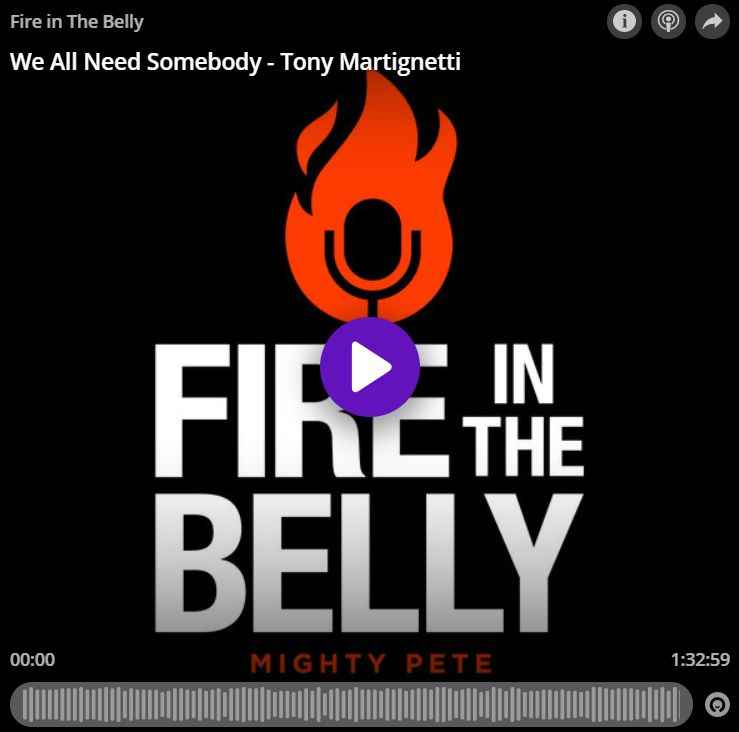 We All Need Somebody - Tony Martignetti
We All Need Somebody - Tony Martignetti
Tags: Leadership, Culture, Business Strategy
 291 | Defining Your Own Fulfillment with Tony Martignetti
291 | Defining Your Own Fulfillment with Tony Martignetti
Tags: Management, Leadership, Business Strategy
 046: Empowering Leaders Through the Culture Journey with Tony Martignetti
046: Empowering Leaders Through the Culture Journey with Tony Martignetti
Tags: Leadership, Culture, Coaching
 Ethical AI: Wisdom For The Age Of Technology With Faisal Hoque
Ethical AI: Wisdom For The Age Of Technology With Faisal Hoque
Tags: Business Strategy, Culture, Leadership
 Pivotal Shifts: Innovating To Differentiate With Stephen Shapiro
Pivotal Shifts: Innovating To Differentiate With Stephen Shapiro
Tags: Business Strategy, Culture, Leadership
Tags: Leadership, Culture, Business Strategy
Tags: Leadership, Culture, Business Strategy
Tags: Leadership, Culture, Business Strategy
Tags: Leadership, Culture, Business Strategy
Tags: Leadership, Culture, Business Strategy
Tags: Leadership, Culture, Business Strategy
Tags: Leadership, Culture, Business Strategy
Tags: Leadership, Culture, Business Strategy
Tags: Leadership, Culture, Business Strategy
Tags: Leadership, Culture, Business Strategy
Tags: Leadership, Culture, Business Strategy
Tags: Leadership, Culture, Business Strategy
Tags: Leadership, Culture, Business Strategy
Tags: Leadership, Culture, Business Strategy
Tags: Leadership, Culture, Business Strategy
Tags: Leadership, Culture, Business Strategy
Tags: Leadership, Culture, Business Strategy
Tags: Leadership, Culture, Business Strategy
Tags: Leadership, Culture, Business Strategy
Tags: Leadership, Culture, Business Strategy
Tags: Leadership, Culture, Business Strategy
Tags: Leadership, Culture, Business Strategy
Tags: Leadership, Culture, Business Strategy
 Executive Contributor Brainz Magazine
Executive Contributor Brainz Magazine
Tags: Leadership
 20 life lessons that have built stronger business leaders
20 life lessons that have built stronger business leaders
Tags: Leadership, Coaching

Tags: Management, Leadership, Business Strategy

Tags: Management, Leadership, Business Strategy

Tags: Management, Leadership, Business Strategy

Tags: Management, Leadership, Business Strategy

Tags: Management, Leadership, Business Strategy

Tags: Management, Leadership, Business Strategy

Tags: Management, Leadership, Business Strategy

Tags: Management, Leadership, Business Strategy

Tags: Management, Leadership, Business Strategy

Tags: Management, Leadership, Business Strategy

Tags: Management, Leadership, Business Strategy

Tags: Management, Leadership, Business Strategy

Tags: Management, Leadership, Business Strategy

Tags: Management, Leadership, Business Strategy

Tags: Management, Leadership, Business Strategy

Tags: Management, Leadership, Business Strategy
 Navigating the Fine Line of Authenticity
Navigating the Fine Line of Authenticity
“Authenticity is a collection of choices that we have to make every day. It's about the choice to show up and be real. The choice to be honest. The choice to let our true selves be seen." – Brene Brown
Authenticity in the workplace is often hailed as a key to effective leadership and harmonious team dynamics. It's seen as the golden ticket to building trust, fostering open communication, and creating an inclusive environment. However, there's a less discussed side to this narrative: the risk of overdoing authenticity. Yes, you can overdose on authenticity, and the consequences can be just as problematic as its absence.
At its core, authenticity is about being genuine, honest, and true to your values and beliefs. In a professional setting, it translates to leaders and employees who bring their whole selves to work without the facade of a workplace persona. Authentic individuals are consistent in their actions and words, both in and out of the office. This transparency fosters trust and reliability, essential components of strong leadership and team cohesion.
While authenticity is desirable, an overdose can lead to several unintended consequences. Unfiltered honesty, for instance, can sometimes come off as tactlessness or insensitivity. Leaders who pride themselves on being brutally honest may unintentionally demoralize their team. Similarly, being overly transparent about one's personal life or emotions can blur professional boundaries, leading to discomfort or misinterpretations among colleagues.
Another risk is the potential for authenticity to morph into intractability. When leaders or employees become too entrenched in their ways under the guise of “being true to themselves,” it can stifle adaptability and openness to new ideas or constructive feedback.
Striking the Right Balance:
Contextual Authenticity: Adapt your level of openness to the situation. Not all scenarios require full disclosure of your thoughts or personal life. It’s about finding the right degree of authenticity that suits the professional context.
Emotional Intelligence: Pair authenticity with emotional intelligence. Being aware of how your words and actions affect others is crucial. It’s about being honest but also kind, empathetic, and considerate.
Constructive Honesty: When offering feedback or opinions, do so constructively. It’s possible to be honest and direct without being hurtful or offensive. Frame your feedback in a way that is helpful and uplifting rather than just blunt.
Professional Boundaries: Maintain a clear line between personal and professional life. Sharing personal experiences or challenges can humanize leaders and create relatability, but it’s important to avoid oversharing or burdening employees with personal issues.
Flexibility and Adaptability: Authenticity shouldn’t be an excuse to resist change or feedback. True authenticity involves growth and adaptability, recognizing that one’s core values can still align with new approaches or ideas.
Authenticity is undoubtedly a valuable trait in the workplace, but like all good things, it requires moderation. The key is not to abandon authenticity but to practice it with mindfulness and sensitivity. Balancing authenticity with professionalism, emotional intelligence, and adaptability ensures that it remains a strength, not a liability, in building a successful and harmonious workplace.
Tags: Coaching, Leadership, Management
 The Grounded Leader: Harnessing Humility and Courage
The Grounded Leader: Harnessing Humility and Courage
"True humility is not thinking less of yourself; it is thinking of yourself less." – C.S. Lewis
To prepare our teams for the future, we need to start by admitting that we don't have all the answers. For some leaders, this might seem counter-intuitive. Why would someone follow me if I don’t know the answers? How can they trust me if I am not 100% confident in the plan? But the opposite is true.
I have been working with a CEO at an immuno-oncology therapeutics company. The company’s clinical development pipeline was presenting a big challenge. There were many potential directions to move forward, but the company was exhausting its funding options and had to place a bet on one indication. She felt pressure to decide on the correct path and didn’t want to make the wrong choice or disappoint the team. But, when she approached the challenge with humility and courage, she collaborated with the team to decide on the best option.
Taking ownership and being honest with your team is at the center of most leadership challenges. Your employees respect and believe in you when you take ownership of your decisions and stick to your word. It takes a lot of courage to be this way, but your impact will be powerful. When you stand up and face the truth instead of shifting blame or sweeping things under the rug, you are also modeling an example for others to show up this way. You also want the leaders on your team to own their mistakes and realize that it is okay to be wrong – what you do with that realization is essential.
One of the most well-known examples of authentic leadership is Bill George, Medtronic's former chairman and CEO. He wrote the book Authentic Leadership about his time leading Medtronic during a challenging period of its evolution. According to George, the five traits of an authentic leader are:
Pursuing their purpose with passion
Practicing solid values
Leading with their hearts as well as their heads
Establishing connected relationships
Demonstrating self-discipline
These are compelling traits that are the foundation of an effective leader. However, one thing that these traits all have in common is that they all require a high level of humility and courage. Embracing these qualities not only fortifies us against the tides of change but also inspires those we lead to join us in the journey toward authenticity and shared success. Leaders who stand firm with humility and bravery in their convictions leave indelible marks on their teams and organizations. So, how will you ground yourself in humility to cultivate courage in your leadership today?
Tags: Coaching, Leadership, Management
 Beyond Comfort: How Discomfort Can Lead to Fulfillment and Growth
Beyond Comfort: How Discomfort Can Lead to Fulfillment and Growth
Discomfort is something that most of us try to avoid at all costs. Whether it's physical discomfort, emotional pain, or the discomfort that comes with stepping outside our comfort zone, we often do everything we can to stay in our safe and familiar spaces. However, it's important to remember that discomfort can be a gateway to fulfillment and growth and that some of the most rewarding experiences in life come from pushing ourselves beyond our limits.
Here are some examples of how discomfort can lead to fulfillment:
Pushing your physical limits: Whether it's through exercise, adventure sports, or other physical activities, pushing your body beyond its limits can be incredibly uncomfortable. However, the sense of accomplishment and satisfaction that comes from achieving a physical goal can be truly fulfilling. For example, training for a marathon may be uncomfortable and challenging, but crossing the finish line can be a life-changing experience.
Facing your fears: Fear is one of the most uncomfortable emotions we can experience, but facing our fears head-on can be incredibly rewarding. Whether it's public speaking, skydiving, or confronting a difficult conversation, stepping outside our comfort zone and facing our fears can give us a sense of empowerment and self-confidence that is hard to come by any other way.
Challenging your beliefs: We all have deeply ingrained beliefs and assumptions about the world around us, and challenging those beliefs can be uncomfortable and disorienting. However, exploring new ideas and perspectives can broaden our horizons and help us see the world in a new light. For example, traveling to a new country and immersing oneself in a different culture can be uncomfortable and challenging, but it can also be incredibly eye-opening and fulfilling.
Embracing vulnerability: Vulnerability is uncomfortable because it involves exposing ourselves to the possibility of rejection or failure. However, it's also the gateway to deep connections and relationships. Sharing our true selves with others, even if it feels uncomfortable or risky, can lead to meaningful and fulfilling connections.
So, the next time you feel uncomfortable or anxious, try to embrace it as an opportunity for growth and fulfillment. You might just be surprised at what you find on the other side.
Tags: Coaching, Leadership, Management
 The Power of Set and Setting: Lessons From Hollywood
The Power of Set and Setting: Lessons From Hollywood
The human mind is a complex and powerful tool that is heavily influenced by the environment in which it operates. Our set and setting, or the physical and social environment that surrounds us, can have a significant impact on our thoughts, emotions, and behaviors. This phenomenon has been studied extensively in psychology and has also been explored in various forms of media, including the film industry.
One of the most significant ways in which our set and setting can affect us is by shaping our mindset. Our mindset is the collection of beliefs, attitudes, and assumptions that we hold about ourselves, others, and the world around us. These beliefs can be positive or negative and can significantly impact our ability to achieve our goals and handle life's challenges.
For example, imagine a person who grows up in a supportive and encouraging environment where they are constantly praised for their achievements. This person is likely to develop a growth mindset, where they believe that their abilities and intelligence can be developed over time with effort and perseverance. On the other hand, imagine a person who grows up in a critical and unsupportive environment where they are constantly told that they are not good enough. This person is likely to develop a fixed mindset, where they believe that their abilities and intelligence are predetermined and cannot be changed.
The film industry has explored the impact of set and setting on mindset in various ways. Do you remember the movie Good Will Hunting? In Good Will Hunting, a young man from a working-class background (played by Matt Damon) is a mathematical genius, yet despite his intelligence, he struggles with self-doubt and a lack of confidence due to his upbringing and his social setting. Through therapy and his friend's encouragement, he can overcome these challenges and develop a growth mindset, allowing him to achieve his full potential.
In addition to impacting our mindset, set and setting can also affect our behavior. Studies have shown that environmental cues can trigger specific behaviors, such as smoking or overeating. For example, a person who associates smoking with socializing may be more likely to smoke when in a social setting. Similarly, a person who associates eating with stress relief may be more likely to overeat when feeling stressed.
The film industry has also explored the impact of setting and setting on behavior in various ways. Another classic example is the movie The Breakfast Club, which tells the story of a group of high school students from different social backgrounds who are forced to spend a Saturday together in detention. Throughout the day, they learn about each other's struggles and eventually form a bond. The movie highlights how social settings can impact behavior, as the students' initial stereotypes and prejudices toward each other give way to empathy and understanding.
Our set and setting can significantly impact our mindset and behavior. It is important to be mindful of the environments in which we operate and to strive to create supportive and positive settings that allow us to thrive. The film industry has provided numerous examples of how set and setting can impact us, reminding us of the importance of paying attention to our surroundings and working to create environments that foster growth and positive change.
Tags: Coaching, Leadership, Management
 The Art of Illumination: Finding Meaning and Self-Expression Through Light and Shadows
The Art of Illumination: Finding Meaning and Self-Expression Through Light and Shadows
Imagine for a moment that you had to pick one thing of significant meaning to get permanently tattooed on your body; what would it be? Some of you reading this message already have tattoos on your body that carry significant meaning. I have a few myself, but it is the upcoming one I want to tell you about.
There is an incredible artist who creates these ornately designed boxes that are displayed in a few museums around the world. They hang from the ceiling, perfectly balanced, above the floor and below the ceiling of a room. There is a light inside the box, and everything is designed, measured, and engineered so that every surface of the room is covered in the most exquisite display of shadows and light you have ever seen. It is truly extraordinary.
I love this art because it represents how when the light within each of us shines outward, it creates a display of shadows and light that are always unique and brilliant in their own way.
That is what it is to be human, and that is what carries so much meaning for me. I see that in myself. I see it in the clients I work with, and I see it in the beauty of humanity itself.
I will be getting this as a tattoo within the next few months because, for me, it represents an aspect of who I am and what my life is devoted to. Helping leaders illuminate their path forward by sparking their light within and using the light and shadows to create their unique self-expression that becomes their path to success.
As Walt Whitman said in his poem, "Song of Myself," I am large; I contain multitudes. We all do, and there is space for all of you who you are to play, create, and bring your best self forward. And like anything worth learning, there is an art to it. Those who do not learn the art can feel quite literally trapped in a box, while those who do go on to create incredible things. If you would like to get a sampling of what's possible for you, then let's chat.
Tags: Coaching, Leadership, Management
 The Treasure Within: Creating Space to Ask Yourself Hard Questions
The Treasure Within: Creating Space to Ask Yourself Hard Questions
"The cave you fear to enter holds the treasure you seek." – Joseph Campbell
As human beings, we all have certain questions that we often avoid asking ourselves. Whether it's because we fear the answers or simply don't want to confront the truth, these questions can hold us back from living our most fulfilling lives. However, creating space to ask ourselves these hard questions can be a transformative experience. As Joseph Campbell famously said, "The cave you fear to enter holds the treasure you seek."
So, what are the questions that we are scared to answer? They can vary from person to person, but some common examples include:
These questions can be uncomfortable to think about, but they can also lead to a deeper understanding of ourselves and our desires. By taking the time to reflect on them, we can uncover insights and motivations that we may have been ignoring or denying.
Creating space to ask ourselves hard questions can take many forms. Some people may find it helpful to set aside dedicated time for introspection, such as journaling or meditating. Others may find that taking a break from their daily routine, such as going on a solo retreat or backpacking trip, allows them the mental space to reflect.
One example of someone who created space to ask herself hard questions is writer and podcaster Rachel Hollis. In her book Girl, Stop Apologizing, Hollis shares how she took a solo trip to Hawaii to reflect on her life and goals. During this time, she asked herself difficult questions such as "What do I truly want?" and "What am I willing to sacrifice to achieve my dreams?" This introspection led her to make significant changes in her life and career.
While asking ourselves hard questions can be uncomfortable, it can also be a crucial step toward a more fulfilling life. By confronting our fears and desires, we can gain clarity on what truly matters to us and take steps toward achieving our goals. As Joseph Campbell said, the treasure we seek is often found in the cave we fear entering.
Tags: Coaching, Leadership, Management
 Just Say No to Saying No to Yourself
Just Say No to Saying No to Yourself
"You are confined only by the walls you build yourself." – Andrew Murphy
The Just Say No to Drugs campaign was a powerful movement in the 1980s and the early 1990s, encouraging young people to resist peer pressure and avoid the dangers of drug abuse. While its impact on reducing drug use is debated, the message of saying no to harmful behaviors can be applied to many areas of life. We can use the same approach to break free from the self-limiting beliefs and negative self-talk that hold us back from living our dreams.
Many of us have dreams and goals that we aspire to, but we often hold ourselves back with thoughts like "I'm not good enough," "I don't have the skills or resources," or "I'll never be able to achieve that." Unfortunately, these negative self-talk patterns are common and can be deeply ingrained, often stemming from past experiences, upbringing, or societal conditioning.
However, it's essential to recognize that these self-limiting beliefs are just that – beliefs, not facts. They are opinions and judgments that we have internalized over time, but they do not necessarily reflect reality. By recognizing and challenging these beliefs, we can break free from their grip and start living the lives we truly want.
So, how do we say no to these self-limiting beliefs? Here are some strategies to consider:
Recognize the beliefs: Start by becoming aware of the self-limiting beliefs that are holding you back. Pay attention to the negative thoughts that pop up when you think about your goals or dreams. Write them down if it helps to make them more tangible.
Challenge the beliefs: Once you have identified them, ask yourself if they are true. Are they based on facts or assumptions? Are they helpful or harmful? What evidence do you have to support or refute them?
Reframe the beliefs: Instead of accepting the self-limiting beliefs as truth, try to reframe them in a more positive or empowering way. For example, "I'm not good enough" could become "I'm still learning and growing, and I have the potential to improve." "I don't have the skills or resources" could become "I can learn new skills and find the resources I need to achieve my goals."
Take action: Finally, take action toward your dreams, even if it feels scary or uncomfortable. Remember that growth and progress often come from stepping outside of our comfort zones. Take small steps towards your goals, and celebrate each accomplishment along the way.
By saying no to self-limiting beliefs, we can break free from the patterns that hold us back and live more fulfilling lives. It's not always easy, but with practice and persistence, we can develop a more positive and empowering mindset that supports our dreams and aspirations. So, just say no to saying no to yourself – and start living the life you truly want.
Tags: Coaching, Leadership, Management
 Igniting Leadership Potential: Campfire Lessons for the C-Suite
Igniting Leadership Potential: Campfire Lessons for the C-Suite
In today’s complex and ever-evolving business environment, C-suite leaders constantly search for innovative strategies to guide their organizations. Through my experience as a leadership advisor and insights from my latest book, Campfire Lessons For Leaders, I have found that authentic connection is crucial in leadership, especially during challenging times. Here, we aim to offer C-suite leaders practical guidance and inspiration, drawing parallels between the wisdom shared around campfires and effective, transformative leadership.
Embrace Storytelling in Leadership
Storytelling, an art as ancient as humanity itself, holds immense power in effective leadership. It’s more than just conveying information; it’s about creating narratives that resonate deeply, both emotionally and intellectually, with your audience. In the C-suite, storytelling is a crucial tool for articulating vision, embodying values, and mobilizing teams toward shared goals. It involves framing the corporate journey in a way that both highlights achievements and sets a compelling path for the future.
For instance, consider the challenge of leading through a corporate merger. An effective leader uses storytelling to weave a narrative that engages stakeholders, facilitating a smooth transition and fostering unity. This approach not only ensures buy-in but also enhances the collective understanding and commitment to the new direction. Authentic storytelling in leadership often incorporates vulnerability, sharing both successes and challenges, which humanizes the leadership experience and forging stronger connections.
In addition to mergers, storytelling can be pivotal in navigating crises, launching new initiatives, or driving cultural change. It can transform abstract concepts into tangible realities that people can connect with and rally behind. By sharing stories that embody the company’s values and vision, leaders can create a sense of shared purpose and direction.
Fostering Connection and Collaboration
The essence of a campfire lies in its ability to bring people together, fostering a sense of community and collaboration. This is increasingly important in an era where remote work, cultural diversity, and interdisciplinary projects are the norm. Leaders must create a culture where open communication, mutual respect, and collective problem-solving are ingrained.
One example of this in practice is a biotech CFO who broke down silos within his team by initiating cross-functional workshops and joint projects. This strategy not only improved understanding among team members but also led to more comprehensive and innovative financial solutions, enhancing the organization’s financial agility. This approach fostered connection and collaboration that extended beyond mere team-building; it involved cultivating an environment where diverse perspectives were harnessed to drive collective success.
Effective collaboration also means embracing diversity in all its forms – diversity of thought, background, and experience. It’s about creating a safe space where every voice is valued and can contribute to the organization’s collective wisdom. In a world where innovation is critical to staying ahead, fostering a culture of diverse and inclusive collaboration is not just a moral imperative; it’s a strategic necessity.
Adapting to Change with Agility
In the business world, as in nature, change is constant. C-suite leaders need the agility to adjust their strategies to meet evolving circumstances, much like tending a campfire in shifting winds. This agility is marked by openness to new ideas, flexibility in strategy, and resilience in facing challenges. It’s about anticipating market shifts, embracing technological advancements, and pivoting operations to maintain relevance and competitiveness.
For instance, a CIO leading a digital transformation showcases this agility. By embracing agile methodologies and fostering a culture of innovation, the CIO can guide the organization toward staying ahead of technological advancements and market trends. Such agility in leadership isn’t merely about quick reactions but about fostering an environment where continuous learning and proactive adaptation are integral to the organizational ethos.
Agile leadership also involves being responsive to feedback and willing to course-correct when necessary. It’s about staying attuned to the internal and external environments and being prepared to pivot strategies in response to new information or changing conditions. This agility allows organizations to remain resilient in the face of uncertainty and capitalize on emerging opportunities.
Building Resilience Through Challenges
Resilience is essential for leaders navigating the corporate world’s unpredictable terrain. This quality is about withstanding challenges, managing crises, and maintaining composure and focus under pressure. Resilient leaders view setbacks as opportunities for growth, learning, and innovation.
In my advisory work, I have encountered leaders who have successfully steered their organizations through reputational crises. By leading with transparency and implementing effective recovery strategies, these leaders not only helped their companies weather the storms but also enhanced trust and loyalty among customers and employees, demonstrating resilient leadership.
Resilience also means maintaining a long-term perspective, even when faced with immediate setbacks. It’s about seeing beyond the current difficulties and focusing on the bigger picture – the ultimate goals and vision of the organization. This long-term focus helps leaders navigate through turbulent times, keeping their teams motivated and aligned with the organization’s overarching objectives.
The insights from Campfire Lessons For Leaders offer C-suite executives a comprehensive roadmap for navigating the complexities of modern leadership. These principles – storytelling, connection, adaptability, and resilience – are not just tactical approaches but foundational elements of a holistic leadership style. Embracing these principles can lead to leadership marked by purpose, innovation, and significant impact.
In your leadership journey, whether in the boardroom or beyond, these principles serve as a guiding light, much like the steady glow of a campfire in the wilderness. They remind us that at the heart of effective leadership lies the ability to connect, inspire, adapt, and endure. By internalizing and applying these lessons, C-suite leaders can not only navigate the challenges of their roles but also lead their organizations to new heights of success and transformation.
Tags: Coaching, Leadership, Management
 Embracing Deep Connections
Embracing Deep Connections
"To truly communicate is to connect to others, to feel them and be felt by them." – Janet Malcolm
This past year has been a whirlwind of inspiring milestones. My TEDx talk, Don't Check Yourself at the Door: How to Share Your True Self, has reached 2 million views, and I couldn't be more thrilled. Another highlight? The release of my latest book, Campfire Lessons for Leaders: How Uncovering Our Past Can Propel Us Forward, which I am truly proud of because it highlights the journeys of some remarkable people whom I truly admire.
This past year, more than ever, I have realized something about my work that wasn't clear to me when I started on this journey. My work is about being a catalyst for deeper, more meaningful connections.
I realized that meaningful human connection is the essential spark that ignites our potential. In essence, we become ourselves through connection with others.
Reflecting on the traditional corporate models I had experienced in the past, I have always sensed the suffocation people felt. That's why I have dedicated the last decade to exploring every facet of human interaction, aiming to rekindle the flames of teamwork, relationships, and, ultimately, business success.
As Greg McKeown, author of Essentialism, recently wrote, "We are lonelier than ever because technology steals deep connections through shallow interactions." This is so true. Technology connects us, but it doesn't necessarily nourish us.
Just this morning, I had a conversation with a client from a leadership development program I conducted for a prominent local organization. In our final session, she shared how our journey together brought a new depth to her life. The quality of our connection not only enhanced her thinking and relationships with others but also improved her overall well-being. This is precisely what I strive for – fostering connections that breathe fresh air into the often stagnant spaces within us, sparking the fires of personal and professional success.
As we enter the new year, remember that technology alone isn't enough for humans to thrive. We need something more – something deeper. So, stay tuned for the launch of my new workshop, Campfires of Connection. I am incredibly excited about this project and believe it will be my best yet!
Tags: Coaching, Leadership, Management
 Inspirational Quotes Fuel Our Motivation and Resilience
Inspirational Quotes Fuel Our Motivation and Resilience
Inspirational quotes have long been a source of motivation and encouragement for individuals navigating life's challenges. These concise, thought-provoking statements can shift our mindset, spark creativity, and rekindle our passion for success. But why do they hold so much enduring power to inspire us?
The Science Behind Inspirational Quotes
Neurological impact: Our brains are wired to respond to language, and inspirational quotes can trigger the release of feel-good neurotransmitters like dopamine, serotonin, and oxytocin. These chemicals elevate our mood and promote feelings of happiness and well-being.
Cognitive reframing: Inspirational quotes can help us reframe negative thoughts by offering new perspectives on challenging situations. This mental shift allows us to approach obstacles with a renewed sense of purpose and determination.
The power of brevity: The concise nature of quotes allows them to be easily remembered and recalled during times of need. Their brevity also makes them more likely to be shared, amplifying their impact on a wider audience.
Universality: Many quotes resonate with people across different cultures, backgrounds, and life experiences. This universal appeal underscores the shared human experience and our collective search for meaning and motivation.
Examples of Inspirational Quotes
"Success is not final, failure is not fatal: It is the courage to continue that counts." – Winston Churchill
This quote reminds us that setbacks are a natural part of life, and it is our resilience and determination to keep moving forward that ultimately define our success.
"Believe you can, and you're halfway there." – Theodore Roosevelt
By highlighting the power of self-belief, this quote encourages us to believe in our abilities and take the first step toward achieving our goals.
"The only way to do great work is to love what you do." – Steve Jobs
This quote emphasizes the importance of passion and dedication in pursuing our goals, as these elements drive us to produce our best work.
"It always seems impossible until it's done." – Nelson Mandela
Mandela inspires us to persevere through challenges and remain steadfast in pursuing seemingly unattainable goals.
"The only limit to our realization of tomorrow will be our doubts of today." – Franklin D. Roosevelt
This quote highlights the power of self-confidence, urging us to overcome our doubts and fears in order to unlock our full potential.
Inspirational quotes hold a special place in our collective consciousness, offering powerful reminders of our resilience, determination, and passion for success. By tapping into our emotions, reframing our thoughts, and providing universal wisdom, these concise messages have the ability to motivate and uplift us in times of need. Embracing the power of words can lead to profound personal and professional growth, helping us navigate the challenges and triumphs of our lives.
Tags: Coaching, Leadership, Management
 Mastering Change Leadership: Strategies for Success
Mastering Change Leadership: Strategies for Success
Change is a constant reality in the workplace. Whether it’s a merger, new leadership, or a shift in the industry, the ability to navigate through change is essential for success as a leader. In this article, we will explore some tips on how to navigate through change at work and provide examples of successful change management strategies.
Communicate Effectively
Communication is the foundation of successful change management. It is crucial to keep everyone informed of what is happening, why it is happening, and how it will impact them. Ensure that you are open and transparent in your communication and listen actively to the concerns and feedback of your team members. You may also want to consider holding town hall meetings, focus groups, or one-on-one conversations with your team members to understand and address their concerns proactively.
One example of effective communication during change management comes from Microsoft. When the company underwent a major reorganization, they created an internal website called “One Microsoft” to communicate the changes to employees. The site included videos from top executives, detailed explanations of the changes, and opportunities for employees to provide feedback. This approach allowed Microsoft to keep its employees informed and engaged throughout the process.
Focus on the Positive
Change can be disruptive and stressful, and it’s easy for employees to get bogged down in the negatives. As a leader, it’s your job to help your team members focus on the positive aspects of the change. Highlight the benefits and opportunities that come with the change and encourage your team members to embrace them.
An excellent example of this comes from the Ford Motor Company. When the company underwent a significant restructuring in 2006, the leadership team focused on the positive aspects of the change. They emphasized the company’s commitment to innovation and growth, and they worked to ensure that employees felt a sense of ownership in the changes. By focusing on the positive aspects of the change, Ford successfully navigated through a difficult period and emerged stronger on the other side.
Empower Your Team
During times of change, it’s essential to empower your team members to take ownership of the process. This means giving them the tools, resources, and support they need to adapt to the changes and thrive in the new environment. Encourage your team members to be proactive, take risks, and come up with creative solutions to the challenges they face.
An excellent example of this comes from Starbucks. When the company decided to close its stores for an afternoon of diversity training, the leadership team empowered its employees to take ownership of the process. They provided the employees with the tools and resources they needed to lead the training sessions and encouraged them to be creative in their approach. As a result, the training sessions were a success, and Starbucks emerged as a leader in the corporate world in addressing issues of diversity and inclusion.
Be Flexible
Change is unpredictable, and it’s essential to be flexible and adaptable in your approach. Don’t be afraid to adjust your strategy as the situation evolves, and be willing to pivot if necessary. Keep an open mind and be willing to experiment with new approaches and ideas.
An excellent example of this comes from Amazon. When the company decided to enter the streaming video market, they were faced with significant challenges. They had to compete with established players like Netflix and Hulu, and they had to build their own content library from scratch. However, Amazon was willing to be flexible and adapt their strategy as they learned more about the market. They experimented with different pricing models, invested heavily in original content, and leveraged their existing customer base to promote their service. Today, Amazon Prime Video is a major player in the streaming video market, and its success is due in part to the company’s willingness to be flexible and adapt its approach.
Change is an inevitable part of the workplace, and leaders must be prepared to navigate through it successfully. Effective communication, focusing on the positive aspects of the change, empowering the team, and being flexible are all essential strategies for successful change management. The examples of Microsoft, Ford, Starbucks, and Amazon demonstrate how these strategies can be put into practice and lead to positive outcomes. As a leader, it's crucial to be proactive in preparing your team for change, providing them with the necessary support, and helping them to embrace the opportunities that come with it. By doing so, you can create a culture that is adaptable, resilient, and equipped to thrive in the face of change.
Tags: Coaching, Leadership, Management
 Rediscovering Play: Unleashing Creativity and Joy in Leadership
Rediscovering Play: Unleashing Creativity and Joy in Leadership
In the relentless pursuit of success and productivity, adulthood often leads us away from the simple joy of play. Yet, it's crucial to recognize that play isn't just a whimsical pastime reserved for children. It's a vital element that can rejuvenate, inspire, and drive innovation in our adult lives, especially in leadership.
The Power of Play
Play is a state of mind where imagination reigns, boundaries blur, and new possibilities emerge. When you adopt a play mindset, risks and experiments become gateways to innovation, allowing leaders to envision and explore solutions beyond conventional boundaries. This mindset can fuel creativity and spark unique ideas, often leading to groundbreaking solutions in business and leadership.
Beyond sparking creativity, play is instrumental in personal development. It nurtures confidence, hones social skills, and enhances emotional intelligence. In a playful setting, interactions are spontaneous and joyful, fostering deeper connections and building a sense of community. For leaders, this means cultivating a culture where playfulness is intertwined with serious work, leading to a more engaged and cohesive team.
Integrating Play into Leadership
To infuse play into your leadership style, start by scheduling it as a non-negotiable part of your routine. This could mean dedicating time for creative brainstorming, engaging in team-building activities, or even incorporating playful elements into regular meetings. Embrace hobbies or activities that ignite your passion and creativity, and encourage your team to do the same.
Play thrives on curiosity and openness. Adopt an explorative attitude towards new experiences, welcoming the unknown with excitement. This can mean stepping out of your comfort zone and trying unconventional approaches in your leadership and problem-solving strategies.
One of the most liberating aspects of play is its detachment from the pressure of perfection. In play, mistakes are not failures but part of the learning and exploration process. Embracing this mindset can relieve the stress of always needing to 'get it right' and can encourage a more innovative, resilient approach in both personal and professional endeavors.
Rekindling the spirit of play is more than a return to childhood; it's a journey toward a more fulfilled, creative, and effective leadership style. By prioritizing play, embracing curiosity, and accepting imperfection, leaders can unlock a world of possibilities, leading to greater joy, innovation, and growth. Remember, in the land of play, the potential for discovery and transformation is limitless. Embrace the expansive power of play in your leadership and lives starting today!
Tags: Coaching, Leadership, Management
 Embracing Growth, Connection, and Gratitude Along the Way
Embracing Growth, Connection, and Gratitude Along the Way
Embarking on a journey toward your goals can feel daunting, especially when it seems like the road ahead is long and uncertain. However, it's important to remember that the journey toward success is full of moments of beauty and growth and that the people we meet along the way can have a profound impact on our lives.
Here are some tips to help you make the most of your journey:
Stay focused on your goal: While it's important to appreciate the moments of beauty and connection that come along the way, it's also important to keep your eye on the prize. Set a clear goal for yourself, and break it down into smaller, achievable steps. This will help you stay motivated and focused, even when the going gets tough.
Cultivate a growth mindset: Embrace challenges and setbacks as opportunities to learn and grow. Instead of seeing failure as a roadblock, see it as a chance to learn and improve. This mindset will help you stay resilient and persistent in the face of obstacles.
Embrace the journey: Remember that success is not just about reaching your destination - it's also about the experiences and lessons you gather along the way. Stay present in the moment, and appreciate the beauty and joy that can be found in even the most challenging situations.
Connect with others: One of the greatest gifts of any journey is the people we meet along the way. Take the time to connect with others, whether it's through networking, mentorship, or simply building relationships with those around you. These connections can offer support, guidance, and inspiration and can help make the journey feel less lonely.
Practice gratitude: Finally, take time each day to reflect on the moments of beauty and connection that you encounter on your journey. Whether it's a kind word from a stranger or a breathtaking view, focusing on these moments of gratitude can help you stay positive and motivated, even when the road ahead seems long and uncertain.
Tags: Coaching, Leadership, Management
 Your Next Big Idea: A Compass for Personal and Professional Growth
Your Next Big Idea: A Compass for Personal and Professional Growth
"To dare is to lose one's footing momentarily. Not to dare is to lose oneself." - Soren Kierkegaard
Have you ever had the sinking realization that you have become a version of yourself that isn't operating at the level you once were? It can feel like a gentle drift of the current that subtly pulls you off track, leading you miles away from where you initially aimed. It's a normal human experience, one that often goes unnoticed until it's too late.
The question is, what do you do when you find yourself drifting? Some may realize they are off course and promptly correct it. Others may get swept away, lost to the tides of complacency. The solution to this common problem resides in a powerful principle that I share with my clients: "Be known for your next idea, not your last idea."
This statement isn't just a motivational catchphrase but a guiding compass for personal and professional growth. It reminds us that while our past achievements build trust, our future vision is what inspires others to follow. It's not about what you have accomplished but where you're taking it next.
Jesse Itzler, the renowned American entrepreneur, captured this spirit when he said, "I didn't come this far, just to come this far." Are you settling for past glories, allowing your trophies to gather dust? Or are you using your experiences as a springboard toward something even greater?
Being at the cutting edge of your evolution means consistently creating, adapting, and growing. It's a dynamic, almost Darwinian relationship with your work, where new ideas are birthed, nurtured, and sometimes allowed to die to make room for something even more extraordinary.
Embracing this approach isn't just about career growth; it's about life itself. When you breathe energy into your next idea, you align yourself with the cutting edge of your own evolution. This alignment isn't merely about success; it's where life, opportunity, and miracles converge.
So, what's your next big idea? What will take you from drifting to directing your course? By focusing on where you are going instead of where you've been, you can forge a path that not only fulfills your vision but inspires others to believe in and invest in your journey.
In the words of the philosopher Soren Kierkegaard, "To dare is to lose one's footing momentarily. Not to dare is to lose oneself." Now's the time to dare, embrace your next idea, and be at the cutting edge of your evolution.
Tags: Coaching, Leadership, Management
 Time-Travel Model for Transformational Leadership
Time-Travel Model for Transformational Leadership
"The true essence of leadership is temporal agility – navigating the past with empathy, the future with vision, and the present with actionable intent."
As leaders, we are often encouraged to focus on the here and now or to look to the horizon, planning the next milestone. But what if the key to impactful leadership lies in a different place – across the continuum of time itself?
When I work with clients, I introduce them to the Time-Travel Model for transformational leadership. This three-dimensional approach asks you to venture into the past, dream about the future, and enable action in the present. So, let's embark on this metaphysical journey to unravel your untapped leadership potential.
Empathize: A Compassionate Journey to the Past
Our first stop is the past, where your beliefs, values, and strengths are forged. Here, we deploy the power of empathy to grasp your roots, your formative experiences, and your first triumphs and setbacks. By traveling to your past, you acknowledge the steps that led you to the present moment. You validate your experience and approach it with compassion. This practice enables you to connect with your core, recognize patterns, and realize the strengths that have been with you all along.
Envision: Projecting into the Promised Future
Now, we propel ourselves into the future, your desired future. What legacy do you want to leave behind? What impact do you want to make on your community, organization, or even the world? What does fulfillment look like for you?
This is where the essence of visionary leadership comes into play. Your envisioned future becomes the compass that guides your decisions and actions in the present. It aligns you with your aspirations and gives you a framework to evaluate current opportunities and challenges.
Enable: Grounding the Future in the Present
Finally, we return to the present moment, equipped with rich insights from your past and a compelling vision of your future. None of these things will matter unless you take intentional action right now. What immediate step can you take that aligns with your future aspirations and acknowledges your past journey?
Enabling is about utilizing your renewed understanding to reframe your current challenges and opportunities. This could mean anything from revisiting your company's strategy to adjusting your communication style. The goal is to take grounded, purposeful steps aligned with your vision and respectful of your journey.
Your Personal Time Machine
The Time-Travel Model is your metaphorical flux capacitor, enabling you to surf the temporal waves with ease. It empowers you to create a leadership approach that is profoundly empathetic, visionarily impactful, and anchored solidly in actionable reality.
As you journey through time, you may discover that your future self is actually someone you can start becoming today. Are you ready to turn the key on your own personal time machine?
Tags: Coaching, Leadership, Management
 Navigating Chaos: Harnessing Courage, Curiosity, Compassion
Navigating Chaos: Harnessing Courage, Curiosity, Compassion
I was recently interviewed on USA Business Radio, and I wanted to share the article here so you can check it out. Click here
In our fast-paced world, it’s easy to feel overwhelmed by the constant turmoil around us. Staying grounded amid the chaos is not just a skill; it’s a necessity. But how do we do that effectively? The answer lies in three powerful tenets: courage, curiosity, and compassion.
Let’s start with courage. It's about more than just bravado or fearlessness. Courage is the inner strength that helps us face adversity head-on. It pushes us to take that first step into the unknown, even when everything inside us is saying, 'This is uncomfortable, maybe even a little scary.' Remember, courage doesn't mean the absence of fear; it's about acting in spite of it. It’s about making tough decisions, even when they’re unpopular or challenging.
Now, let's talk about curiosity. In times of uncertainty, curiosity is our best friend. It opens doors to new understanding and perspectives. Curiosity drives us to ask, 'What’s really happening here?' It leads us to explore different possibilities, to look beyond the surface, and to adapt to the ever-changing landscape. When we are curious, we become learners and adaptors – we evolve. It’s about embracing change, not resisting it.
Compassion is the third tenet and perhaps the most vital. Compassion starts with ourselves – it’s giving ourselves the grace to make mistakes, to not have all the answers. It's understanding that sometimes, we're doing the best we can under challenging circumstances. And then it extends to others. Leading with compassion means recognizing the challenges your team, your peers, or even your adversaries may be facing. It’s about building connections, fostering resilience, and creating an environment where everyone feels supported and understood.
Combining these three – courage, curiosity, and compassion – creates a powerful toolkit for navigating through chaos. This toolkit not only helps us stay grounded but also empowers us to lead others with confidence and empathy. As leaders, it’s our responsibility to set the tone to model these behaviors. By doing so, we create an atmosphere where challenges are met with innovative thinking, empathy, and resilience.
In conclusion, remember that navigating chaos is not about having all the answers. It's about being open to finding them together. It's about being brave enough to face the unknown, curious enough to explore it, and compassionate enough to support each other through it.
You can learn more about me and how I help leaders navigate their journeys at www.ipurposepartners.com.
Tags: Coaching, Leadership, Management
 Finding Fulfillment in Life's Little Pleasures
Finding Fulfillment in Life's Little Pleasures
“Enjoy the little things, for one day you may look back and realize they were the big things." – Robert Brault
In a world that often emphasizes the importance of material possessions and external achievements, it can be easy to overlook the simple pleasures that bring us joy and fulfillment. Research shows that true happiness does not come from the big moments but from the little moments that make up our everyday lives.
Fulfillment comes from the simple things, the little moments that we often take for granted. It might be the warmth of the sun on our skin, the sound of birds singing in the morning, or the taste of our favorite meal. These small pleasures may seem insignificant, but they add up to create a sense of joy and contentment that cannot be found in material possessions or external achievements.
Focusing on simple moments can help us to cultivate a sense of gratitude and appreciation for the present moment. When we slow down and pay attention to the beauty that surrounds us, we become more mindful and present, which can improve our mental health and overall well-being.
So, how can we cultivate a greater appreciation for life's little pleasures? The first step is to slow down and be present in the moment. Whether it's taking a few deep breaths, going for a walk in nature, or simply savoring a cup of coffee, taking the time to appreciate the simple things can help us feel more grounded and connected.
Another important aspect of finding fulfillment in simple moments is to practice gratitude. By focusing on what we are grateful for in our lives, we can shift our attention away from what we lack and toward what we already have. This can help us to feel more content and fulfilled, even in the midst of life's challenges.
Fulfillment comes from the simple things, the little moments that make up our everyday lives. By slowing down and appreciating the beauty that surrounds us, we can cultivate a greater sense of joy and contentment. Practicing gratitude and being present in the moment can help us find fulfillment in life's small pleasures and create a more meaningful and satisfying life.
Tags: Coaching, Leadership, Management
 Turning Personal Quirks into Superpowers
Turning Personal Quirks into Superpowers
"What makes you different or weird, that's your strength." – Meryl Streep
Let's talk about those unique traits that we often dismiss - qualities that, upon closer inspection, are nothing short of superpowers in disguise. Take my wife, for instance. She possesses an incredible degree of patience. It may look like procrastination to the casual observer, but it is a finely tuned sense of timing. She waits for the perfect moment to act and invariably nails it when she does.
Then there's me. I have an insatiable appetite for collecting books on art, architecture, and leadership - far more than I'll ever have time to read. Yet, this diverse collection of curated knowledge becomes instrumental when I collaborate with organizations to optimize their resources, generate new ideas, and unlock their potential. So yes, it's my personal form of alchemy - my own superpower.
What about you? Have you ever considered that what others label your quirks could be your most valuable assets? Whether you are described as too sensitive or decisive, too laid-back or ambitious, each quality holds a hidden gift. Outspoken individuals can act as catalysts for change, while quieter souls offer the invaluable advantage of truly listening to people. Sensitive people often pause to think before they act, whereas those less sensitive are primed to make bold leaps.
The point is that whatever makes us weird is also what makes us wonderful. Rather than shying away from these quirks, recognize them as the specialized tools they are – tools that prepare you for specific challenges only you can solve. Once you embrace these traits as part of your innate artistry, they transcend to the level of superpowers.
However, it's also worth noting that even superpowers need to be balanced. Focusing solely on your unique gift could lead to a one-dimensional life. But when cultivated consciously – integrated and balanced within the scope of your broader existence – these idiosyncratic abilities morph into refined art forms that empower you in extraordinary ways.
So the next time you catch yourself downplaying your peculiarities, pause and reconsider. Could it be that these very traits are the secret ingredients that contribute to your unique recipe for success? I would bet on it.
Tags: Coaching, Leadership, Management
 Proactive Communication: Why it's Everyone's Responsibility
Proactive Communication: Why it's Everyone's Responsibility
In today's fast-paced business world, proactive communication is more important than ever. And while many believe that it's the sole responsibility of leadership to drive this culture, the reality is that everyone has a role to play.
A proactive culture is one where communication is not just about responding to messages or putting out fires but rather anticipating and addressing issues before they become problems. It's a culture where everyone takes ownership of their communication and understands the impact it has on the success of the team.
Here are a few examples of how proactive communication benefits everyone:
So, what can individuals do to promote proactive communication? Here are a few tips:
Creating a proactive culture cannot be achieved overnight, but it's a worthwhile goal. When everyone takes ownership of their communication and strives to be proactive, the benefits are clear. Improved collaboration, increased efficiency, and reduced stress are just a few of the many benefits that come from a workplace culture where proactive communication is everyone's responsibility.
Tags: Coaching, Leadership, Management
 The Check Engine Light: Recognizing and Preventing Burnout
The Check Engine Light: Recognizing and Preventing Burnout
"It's not the load that breaks you, it's the way you carry it." – Lou Holtz
Much like a vehicle's engine working at high RPMs for extended distances, we, too, risk burnout when constantly operating at peak performance. Unlike a car that has a clear "Check Engine Light," our own warning system can be less obvious. Recognizing our own signs is a sophisticated art. So, let's deepen our understanding of these symptoms and explore the nuanced strategies that can help us navigate away from the brink of exhaustion.
The Symptoms of Approaching Burnout:
Chronic Fatigue: More than just tiredness, this is an enduring sense of physical, emotional, and mental exhaustion.
Declining Productivity: Stalled or diminishing output isn't merely about workload but often reflects rising disengagement.
Emotional Volatility: Unexplained irritability and heightened conflict can indicate our emotional reserves are running low.
Increasing Disengagement: A lack of interest or passion for work usually indicates that the spark that fuels your drive is flickering.
Now, let's transform these warning signs into catalysts for action.
Strategies for Dealing With Burnout:
Scheduled Self-Audits: Treat yourself as you would an intricate project. Set aside a 'maintenance window' each week to evaluate your mental, physical, and emotional health. Detect anomalies before they become crises.
Empower Through Delegation: Take the case of a CTO I coached who was on the brink of burnout from hoarding responsibilities. After prioritizing delegation, she refocused on her zone of genius, innovation and leadership and empowered her team in the process.
Self-Care as a Priority: I worked with a tech entrepreneur who rejuvenated his approach to work by making self-care non-negotiable - integrating exercise, nutrition, and mindfulness. He reignited his passion and diminished his burnout.
Nurture a Support Ecosystem: We often underestimate the power of a robust support network. My go-to strategy includes leaning into my network when I am feeling off-kilter. A mentor or even a friend can provide fresh perspectives or emotional sustenance when we need to be seen or heard.
Enforce Boundaries: A marketing executive I worked with learned to designate 'off-hours,' creating physical and mental spaces that are work-free zones. This simple change revolutionized her work-life equilibrium.
By more intentionally interpreting our "internal check engine light," we are better equipped to enact meaningful changes. It isn't just about avoiding fatigue; it's about creating a holistic, sustained level of high performance that incorporates well-being as a core metric. This is how we transcend the race against burnout and evolve into leaders who are not only efficient but also resilient and fulfilled.
Tags: Coaching, Leadership, Management
 How Grateful Leaders Foster Connection and Disrupt the Status Quo
How Grateful Leaders Foster Connection and Disrupt the Status Quo
In an era where leaders are urged to push boundaries, drive innovations, and relentlessly aim for growth, the idea of expressing gratitude might seem quaint, if not utterly irrelevant. But herein lies a counterintuitive wisdom: While aspiring to change the world, the most revolutionary act a leader can take is often the simplest – cultivating gratitude.
Gratitude has long been the subject of various spiritual teachings and psychological studies, but its revolutionary potency in organizational settings is underappreciated. It is often viewed as a 'soft' emotion, typically confined to the boundaries of personal life and undeserving of a place in the high-stakes game of leadership. This is where most leaders go astray.
Gratitude as Disruptive Innovation
When we think of disruptive innovations, our minds often drift to groundbreaking technologies or business models that completely overhaul established industries. Yet, in the field of leadership, gratitude can be the disruptive force that challenges the norms of hierarchical systems and transactional relationships.
Incorporating gratitude in your leadership style changes the game, transforming mundane exchanges into opportunities for connection. Imagine walking into a board meeting, where rather than diving into KPIs and ROIs right away, you pause to express genuine appreciation for everyone’s hard work. This act doesn’t just set a positive tone; it invigorates the room, fosters openness, and dismantles the defensive walls people often construct.
The Science of Gratitude
Research has shown that gratitude has a profound impact on mental health, elevating mood, reducing stress, and improving overall well-being. A study from UC Davis revealed that participants who kept a weekly gratitude journal reported fewer physical symptoms, felt better about their lives as a whole, and were more optimistic about the upcoming week compared to those who didn’t.
By expressing gratitude, you are not just engaging in a fleeting moment of politeness; you're promoting a mentally healthier work environment. This facilitates deeper interpersonal connections, which in turn sparks collaboration and drives innovation.
A Grounded View of Gratitude
As leaders aiming for high impact without burnout, it’s crucial to be grounded and intentional. A Grounded Gratitude Model consists of three key elements:
From Thought to Action
Consider adopting a "Gratitude Time," a dedicated time and space where team members can share what they are thankful for, both personally and professionally. Leverage blockchain technology to create a 'Gratitude Ledger,' a transparent record where employees can track and even quantify their expressions of gratitude. It may sound unconventional, but sometimes the most groundbreaking ideas emerge from combining the deeply human with the radically new.
By embedding gratitude into the organizational culture, we can create a cascade of benefits that go far beyond improving individual well-being. We turn our workplaces into hubs of innovation fueled by the authentic connections that gratitude nurtures.
So, the next time you are striving to break new ground, remember revolutionary leadership might just begin with a simple "thank you."
Tags: Coaching, Leadership, Management
 Charting a Fearless Path: Discovering Your Inner Growth Compass
Charting a Fearless Path: Discovering Your Inner Growth Compass
"You have within you right now everything you need to deal with whatever the world can throw at you." – Brian Tracy
Do you know how to access your own inner growth compass? Navigating the complexities of business, life, and relationships can be daunting, and it is not always clear which direction to take. In the midst of uncertainty, how can you be sure you are on the right path? It is essential to learn how to access your inner growth compass and trust its guidance.
Many people believe that if something feels scary, confusing, or uncomfortable, we should avoid it. While this is sound advice when it comes to physical danger, it's a different story when it pertains to personal growth.
Throughout my life, I have been terrified of public speaking. However, I discovered that this fear and uncertainty were actually signals from my inner growth compass, guiding me toward the areas I needed to develop. Joseph Campbell's famous quote, "The cave you fear to enter holds the treasure you seek," perfectly captures this idea.
Embracing my fear, I joined a public speaking program, secured keynote speeches, and prepared for my first TEDx talk. As I faced these challenges head-on, I experienced profound fulfillment and aliveness. My fears served as a guiding light, directing me toward personal growth and achievement.
As a coach to high-performers, I recognize that I can only take my clients as deep as I am willing to go myself. That is why learning to trust my own inner guidance system is so important because it allows me to teach my clients to do it for themselves. If you aim to make a difference, create abundance, and play a big game in life, learning to trust your inner compass is one of the most powerful tools at your disposal.
Tags: Management, Leadership, Coaching
 Us and Them: Two Sides of Emotional Intelligence
Us and Them: Two Sides of Emotional Intelligence
Are there any Pink Floyd fans out there?
I was recently working with a client on the five foundations of emotional intelligence and realized the Pink Floyd song "Us and Them" might be a great way to look at it. In fact, once you have read this article, you might want to go and enjoy the song. I will put a link at the bottom.
To connect with others meaningfully, we first have to connect with ourselves because if you can't understand yourself, then you certainly can't understand others.
Emotional intelligence is built on five foundations, as proposed by Daniel Goleman. What is cool is that you can see how each one naturally stands on the shoulders of the previous. So, the first three are about "Us" (yourself), and the last two are about "Them" (others).
Self-awareness is the opening verse. It is the ability to recognize and understand our emotions, strengths, weaknesses, and values. Think of it as the tuner of our inner radio – aligning us with our own experience. An actionable tip to enhance self-awareness is to practice mindfulness. Spend a few minutes each day in quiet contemplation, focusing on your thoughts and feelings.
Self-regulation follows, like the rhythm section. It is the capacity to manage our emotional responses and impulses, especially in challenging situations. It is about reflecting on our inner turbulence when we are triggered instead of impulsively reacting. Try techniques such as deep breathing or counting to ten when you feel triggered to enhance self-regulation. This pause can give you the space to respond more thoughtfully.
Motivation is the chorus, driving the song forward. It is our ability to harness emotions to achieve personal and professional goals and maintain enthusiasm and persistence in the face of obstacles. Boost your motivation by setting clear, achievable goals and tracking your progress. Celebrate small victories along the way to keep your momentum.
These first three were all about us, but now we transition to "Them."
Empathy is the harmonizing melody. Empathy is our ability to understand and share the feelings and perspectives of others and show genuine concern for their well-being. It is like the harmonizing melody in a song, complementing and enriching the overall composition. Improve empathy by actively listening to others and trying to understand their perspective. Practice putting yourself in their shoes.
Finally, we have social skills, the finishing touch that brings the whole song together. It is about building and maintaining positive relationships, communication, conflict resolution, and teamwork. In essence, having a positive and healthy relationship with the world around us. To enhance your social skills, seek feedback from your peers, engage in team-building activities, and practice active listening and clear, respectful communication.
As Pink Floyd said, "Remember when you were young? You shone like the Sun." These five foundations of emotional intelligence represent humanity at its best, and it's never too late to get good at them. It only makes business, life, and relationships better for you and everyone around you. Shine on, you crazy diamond!
Pink Floyd's Us and Them: here
Tags: Coaching, Leadership, Management
 Finding Freedom Through Exploration and Boundaries
Finding Freedom Through Exploration and Boundaries
Life is an adventure, and every day presents us with opportunities to explore new territory and new possibilities and to expand our horizons. However, with so much to see and experience, it can be easy to feel overwhelmed and lost. That's why it's important to create beautiful and powerful boundaries that can help guide us toward our goals and filter out distractions.
Exploring new territory is essential for personal growth and development. It allows us to challenge ourselves and learn new things, which can be exhilarating and empowering. Whether it's traveling to a new country, trying a new hobby, or taking a new job, exploring new territory can help us to discover new aspects of ourselves and the world around us.
At the same time, it's important to create boundaries that help us to stay focused and true to our values. Boundaries allow us to filter out distractions and say no to things that don't align with our goals and priorities. By setting clear boundaries, we can create a sense of control and agency over our lives, which can be incredibly liberating and empowering.
Creating boundaries can take many forms. It might mean setting limits on how much time we spend on social media, saying no to commitments that don't serve us, or setting boundaries in our relationships to protect our emotional well-being. Whatever form it takes, boundaries are a powerful tool for creating a sense of freedom and control in our lives.
Filtering our way to freedom also means being intentional about what we allow into our lives. It means taking control of our environment and consciously choosing what we consume, both mentally and physically. By being mindful of the information we consume, the people we surround ourselves with, and the products we use, we can create a life that aligns with our values and supports our goals.
By embracing new experiences and setting powerful boundaries, we can create a life that is fulfilling, joyful, and aligned with our values. Filtering our way to freedom means being intentional about what we allow into our lives and consciously choosing the information, people, and products that support our goals.
Tags: Coaching, Leadership, Management
 Breaking Through the "That's How We've Always Done It" Barrier
Breaking Through the "That's How We've Always Done It" Barrier
Change is the only constant in life, and the same holds true for organizations. There comes a pivotal moment in every organization's lifecycle when change is not merely an option but a requisite for growth and survival. Yet, when leaders seek to implement transformative changes, they often confront a monolithic wall of resistance labeled, "That's how we've always done it." But great leaders, leaders who are grounded, know how to navigate this resistance to bring about effective organizational change. Below, we dig deeper into each phase of this change journey, providing concrete examples and fresh perspectives to enrich your leadership toolkit.
Assess the Landscape
Lead with Vision
Operationalize the Change
Unearth the Hidden Champions
Cultivating a Culture of Adaptability
Leading change in a resistant environment is akin to sailing against the current; it demands more than skill - it requires courage. The steps outlined above are not quick fixes but rather guideposts on a longer journey toward instilling a culture of adaptability and growth. As you navigate change, remember that the strongest leaders are those who listen, empathize, and inspire. With intention and strategy, you can turn the tides and lead your organization toward uncharted waters of success.
Tags: Change Management, Coaching, Leadership
 90-Minute Mindset Shift Session
90-Minute Mindset Shift Session
Location: Virtual Fees: 1,200
Service Type: Service Offered
 45-Minute Clarity Session
45-Minute Clarity Session
Location: Virtual Fees: 500
Service Type: Service Offered